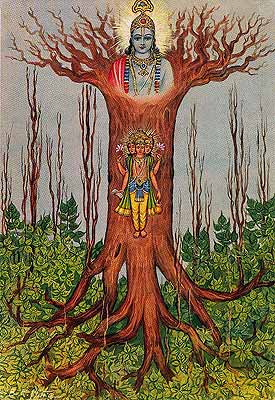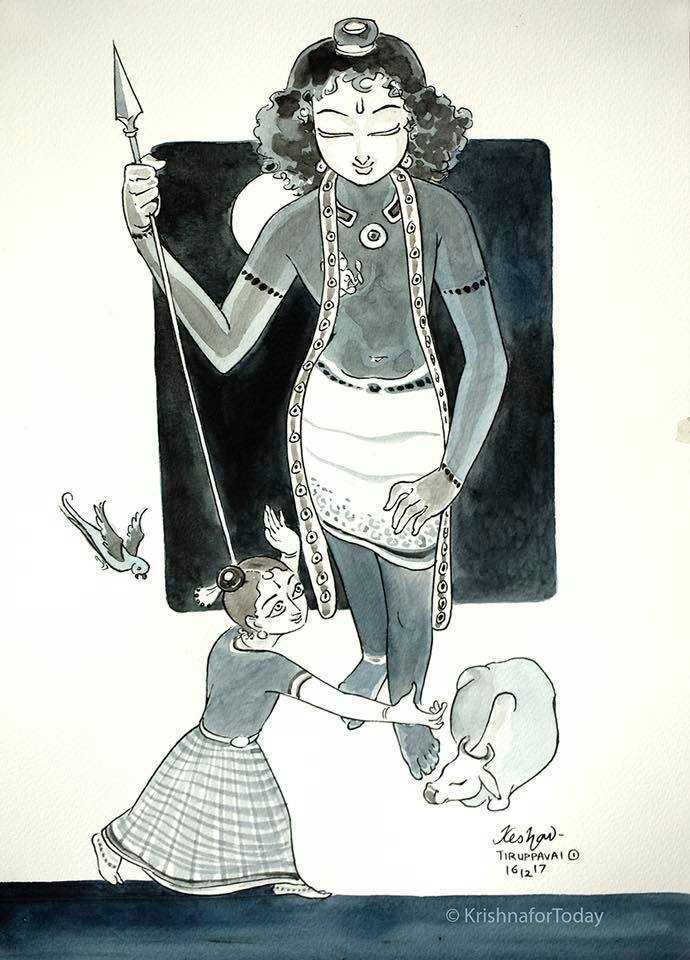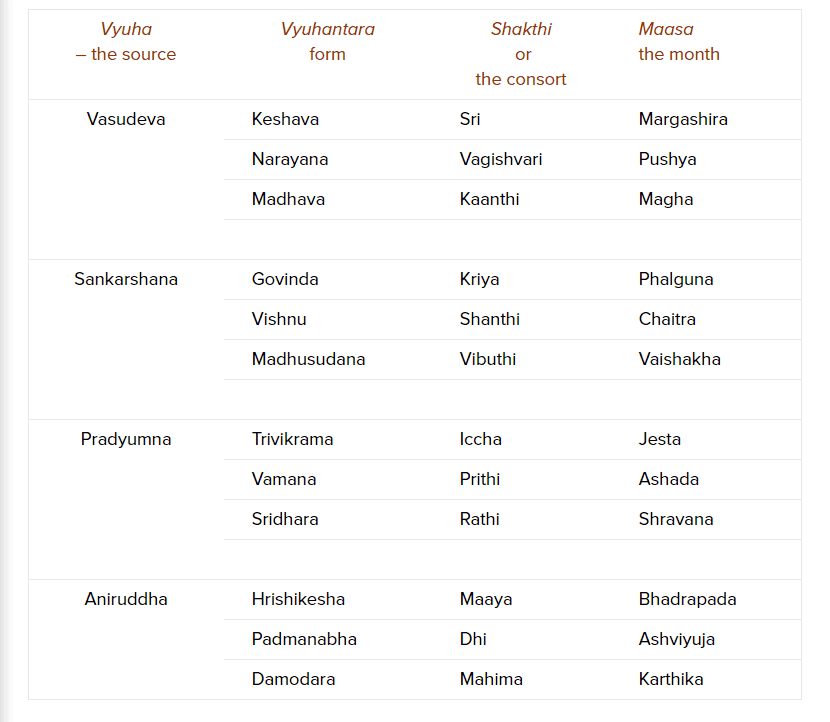2017 has been really kind to me and it has been a great year in terms of my “getting back to blogging” goal. Few days(nights) after Saathvik’s birth, I had a sudden urge to learn something and given the onset of December, I decided it is going to Thiruppavai.
Disclaimers about this series:
- Not aimed at a religion promotion
- Purely my understanding which I hope to revisit every year to correct/add.
This series will be a compilation of various interpretations I read and enjoyed this year and my own takeaways from them. With all due respects to Aacharyan and learned people who took time to write their interpretations, here is my own series.
Special thanks to Krishna for Today for the adding visual brilliance to Thiruppavai.
Verse 1:
மார்கழித் திங்கள் மதிநிறைந்த நன்னாளால்;
நீராடப் போதுவீர்! போதுமினோ, நேரிழையீர்!
சீர்மல்கும் ஆய்ப்பாடிச் செல்வச் சிறுமீர்காள்!
கூர்வேல் கொடுந்தொழிலன் நந்தகோபன் குமரன்,
ஏரார்ந்த கண்ணி யசோதை இளஞ்சிங்கம்,
கார்மேனிச் செங்கண் கதிர்மதியம் போல்முகத்தான்
நாரா யணனே, நமக்கே பறைதருவான்,
பாரோர் புகழப் படிந்தேலோ ரெம்பாவாய்.Apart from its religious significance, Thiruppavai is rich in its language usage and clever analogies that the poet used. The entire month of மார்கழி is dedicated to Thiruppavai.
The first question to ask, why only this month?
Like Kannadhasan’s famous மாதங்களில் அவள் மார்கழி, Krishna says, மாதங்களில் நான் மர்காஷிரிஷா (மார்கழி )
I am going to skip the ozone layer explanation to December/Margazhi here.
Apart from that, it is said that Keshava is a name associated with Margazhi month. Now, this leads us to what are the other names and associations. To trace that, it would be easy if we understand how Vishnu came to be associated with Supremeness. In Rig Veda, Vishnu is considered as one of the 33 devas. There are about 6 verses that are dedicated to him - Vishnu Sukta. These verses glorified him as God of Gods, equated him to Sun, extolled him to be the reason for existence and hence the supremeness. Iconography and the mythology around Vishnu are all fueled by these 6 Suktas. For instance, the first sukta describes the three strides of Vishnu as Tri vikrama where the first and second strides (Earth and mid-air region) were visible and the third one is invisible(outer space). From there came the bhu(Earth), Bhuva (Air) and Suvah (Outer space). Given Vishnu is equated to Sun, there is one other interpretation where the three strides are three forms of heat source - Fire in Earth region, Lightning in the mid-air region and Sun in the outer space region.
These Suktas also propound that Vishnu is set in the wheel of time that has 94 elements:
- Samvathsara (year-1)
- Aayana (Half-year: 2)
- Ritu (seasons -5)
- Maasa (months-12)
- Paksha (fortnights-24)
- Aho-ratri (solar days-30)
- Yama( roughly hours or parts of the day- 8)
- Lagnas in each day(12)
Till date Panchangams are written with these elements as their language. This wheel of time was the reason behind the chakra in iconography.
There is a verse that tells Vishnu with Indra took those three strides. It so happened that, Indra and Vishnu were interchangeably used and so were their qualities/attributes. Indra-Nila was the reason for Vishnu’s sky blue body color in iconography.
For long, it has only been Vishnu and there is no reference to term Narayana(as Vishnu) in Vedas or Bhagavad Gita (Some quote this as a reason to prove Bhagavad Gita was written before Mahabaratha, where Narayana and Krishna are interchangeably used). Narayana in Rig Veda was a person to whom Purusha Sukta was revealed. I consider Purusha Sukta as the bravest analogy one could ever make. It visualizes universe as a cosmic person/human being. Purusha is not a deity who assumes forms, but, he is a cosmic process of creation and destruction, which is similar to how human’s body produces and destroys cells - devouring and being devoured!
Next topic to learn will definitely be
Purusha Sukta
This very sukta has a huge impact on how Vishitadvaitam came into existence. This sukta was based on the fact that the formless entity took a cognitive form so that it can be comprehended.
 This is the famous inverted tree analogy which means the all-compassing
This is the famous inverted tree analogy which means the all-compassing Purusha branched out and permeated into the every existing part of the universe.
Rewriting it in terms of Vishitadvaitam, the Parama Purusha (Supreme being) took the Divya Mangala vigraha (Divine form) due to his compassion towards human beings so that he can be accessible.
The forms he took are five fold:
- Para or the supreme form of his transcendent being
- Vyuha or the group of his forms called Vasudeva, Sankarshana, Pradyumna and Aniruddha brought together in worship and adoration as a complete body of divine power, and who represent the cosmic consciousness, intellect, mind, and the ego respectively
- Vibhava or his glory seen through his incarnations or Avatars
- Archa or his presence manifest in his idols and images worshipped by devotees
- Antaryamin or his immanent presence within the Universe.
The devotee progresses from Vibhava worship to the true form(less) Parama pursha worship. This is my reasoning as to why we have paramapada vasal in Srirangam. Interpreting this as Thiruppavai, which is considered as a crux of Vedas and Upanishads, reciting which during this month of Margazhi, is the stepping stone (vasal) to the path(pada) of para or the first form or the only formless being.
The all famous Vishnu saharsanama is said to be grouped as 1-122 for para fold, 123-144 for vyuha fold and the rest of the vibhava fold. This vyuha gave rise to 24 forms of Vishnu out of which first 12 forms(Dwadhasha murtis) are considered more important(hence 12 thirumans for iyengars). Each of these 24 forms has their own iconography and a reason behind them. There are 12 months and each month takes a name of a Dwadhasha murti, which are as follows:
In the five fold form, vasudeva is the first form and Keshava is derived from this form and has Sri as his consort. So this is more relatable.
Hence Kesava is associated with Margazhi! This is the long answer to the question we had.
`மார்கழித் திங்கள் மதிநிறைந்த நன்னாளால்; நீராடப் போதுவீர்! போதுமினோ, நேரிழையீர்! சீர்மல்கும் ஆய்ப்பாடிச் செல்வச் சிறுமீர்காள்!
` During the month of Margazhi, on a conscious day(meaning, fully aware what we want in the path we take), in an effort to comprehend you(நீராடப் - attain you).
கூர்வேல் கொடுந்தொழிலன் நந்தகோபன் குமரன்,
ஏரார்ந்த கண்ணி யசோதை இளஞ்சிங்கம்,
கார்மேனிச் செங்கண் கதிர்மதியம் போல்முகத்தான்
Now to add adjectives/attributes (true to vishitadvitam being qualified non-dualism) to that you, we need the mythology/avatar view of Parama Purusha. Andal, being a devotee of Krishna, describes you in Krishna’s terms - Krisha, Son of Nandhagopan and Son of the lady with beautiful eyes, Yashoda(இளஞ்சிங்கம் -read as a mom calling her son as Singa kutty),has a dark blue body, red eyes (செங்கண் கதிர்)and a face that has the shine of moon (மதியம் போல்முகத்தான்).
நாரா யணனே, நமக்கே பறைதருவான்,
பாரோர் புகழப் படிந்தேலோ ரெம்பாவாய்.
A person with all these qualities is none other than Narayanan and devotion to him will lead to comprehension of the Parama Purusha.
Reference:
- Sreenivasrao Blog - https://sreenivasaraos.com/
- Ramanuja.org
- Facebook posts of Saroja Ramanujam, Desikan Narayanan

